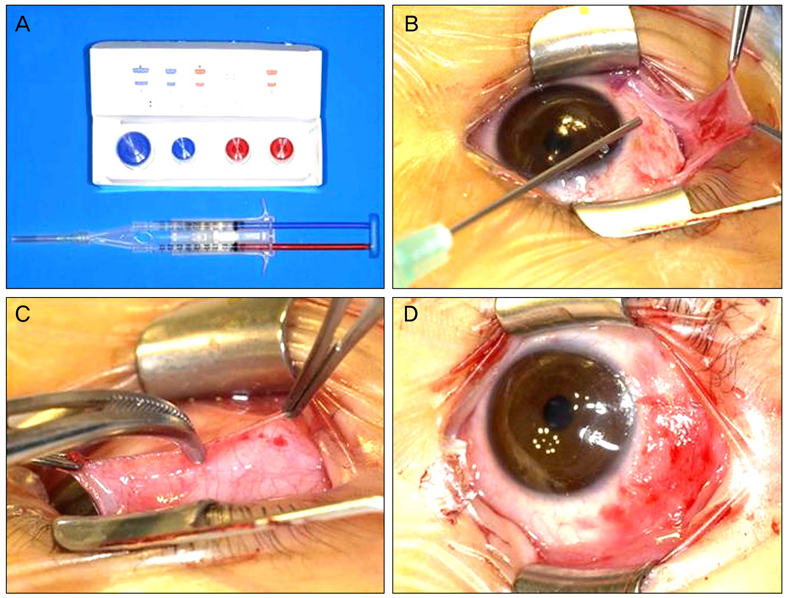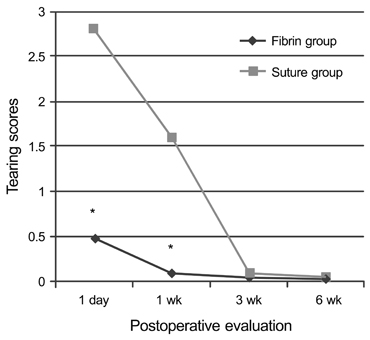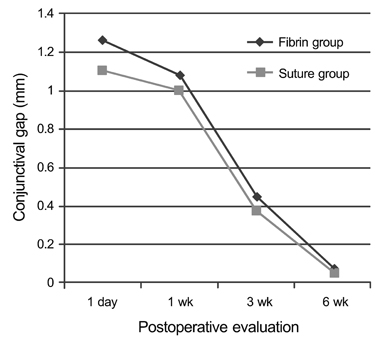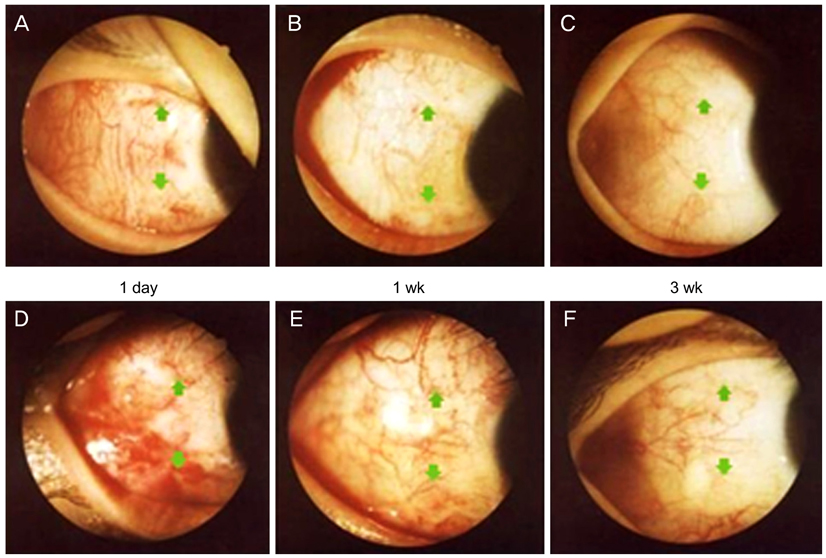Korean J Ophthalmol.
2011 Jun;25(3):178-184. 10.3341/kjo.2011.25.3.178.
Comparison of Fibrin Glue and Sutures for Conjunctival Wound Closure in Strabismus Surgery
- Affiliations
-
- 1Department of Ophthalmology, Bucheon St. Mary's Hospital, The Catholic University of Korea School of Medicine, Seoul, Korea. nyeokang@catholic.ac.kr
- KMID: 1010025
- DOI: http://doi.org/10.3341/kjo.2011.25.3.178
Abstract
- PURPOSE
To evaluate and compare the efficacy and tolerance of fibrin glue and sutures for closing conjunctival wounds in strabismus surgery.
METHODS
In a prospective trial, we performed strabismus surgery using limbal incisions. Conjunctival wounds were closed with fibrin glue in 20 eyes of 20 patients (fibrin group) and 8-0 polyglactin suture in 20 eyes of 20 patients (suture group). Postoperative pain, tearing, and inflammation were compared at 1 day, 1 week, 3 weeks, and 6 weeks after surgery. Conjunctival incision healing was also investigated.
RESULTS
One day and one week post-operatively, pain and tearing scores were lower in the fibrin group (p = 0.000, respectively). Mean surgery time was significantly shorter in the fibrin (48 +/- 5 minutes) than the suture group (63 +/- 7 minutes) (p = 0.000). Inflammation was significantly more severe in the suture group until 3 weeks postoperative (p = 0.000, respectively), but conjunctival healing did not differ between the groups. Hyperemia appeared more prominent in the fibrin group 3 and 6 weeks after surgery (p = 0.087 and 0.000, respectively). Two eyes in the fibrin group showed conjunctival gaps of more than 2 mm, which closed spontaneously by three weeks after surgery. No allergic reactions or infections developed.
CONCLUSIONS
Fibrin glue proved to be as effective as sutures in closing conjunctival wounds. It provides more comfortable early postoperative courses and might be considered as an alternative to sutures in strabismus surgery.
MeSH Terms
-
Adolescent
Adult
Child
Child, Preschool
Conjunctiva/*surgery
Fibrin Tissue Adhesive/*therapeutic use
Humans
Inflammation/etiology/pathology
Male
Middle Aged
Pain, Postoperative/etiology/physiopathology
Polyglactin 910
Postoperative Period
Severity of Illness Index
Strabismus/*surgery
*Sutures/adverse effects
Tears/secretion
Tissue Adhesives/*therapeutic use
*Wound Closure Techniques/adverse effects
Young Adult
Figure
Reference
-
1. Coats DK, Olitsky SE. Strabismus surgery and its complications. 2007. Berlin: Springer-Verlag;190.2. Lagoutte FM, Gauthier L, Comte PR. A fibrin sealant for perforated and preperforated corneal ulcers. Br J Ophthalmol. 1989. 73:757–761.3. Asrani SG, Wilensky JT. Management of bleb leaks after glaucoma filtering surgery. Use of autologous fibrin tissue glue as an alternative. Ophthalmology. 1996. 103:294–298.4. Koranyi G, Seregard S, Kopp ED. Cut and paste: a no suture, small incision approach to pterygium surgery. Br J Ophthalmol. 2004. 88:911–914.5. Yoon KC, Heo H, Jeong IY, Park YG. The use of fibrin glue for conjunctival autotransplantation in pterygium. J Korean Ophthalmol Soc. 2006. 47:198–204.6. Kim HH, Mun HJ, Park YJ, et al. Conjunctivolimbal autograft using a fibrin adhesive in pterygium surgery. Korean J Ophthalmol. 2008. 22:147–154.7. Hovanesian JA, Karageozian VH. Watertight cataract incision closure using fibrin tissue adhesive. J Cataract Refract Surg. 2007. 33:1461–1463.8. Mentens R, Stalmans P. Comparison of fibrin glue and sutures for conjunctival closure in pars plana vitrectomy. Am J Ophthalmol. 2007. 144:128–131.9. Lee EK, Kim JY. Fibrin glue for conjunctival closure in pars plana vitrectomy. J Korean Ophthalmol Soc. 2008. 49:1283–1288.10. Kheirkhah A, Casas V, Blanco G, et al. Amniotic membrane transplantation with fibrin glue for conjunctivochalasis. Am J Ophthalmol. 2007. 144:311–313.11. Nam K, Jo YJ, Lee SB. The efficacy of fibrin glue in surgical treatment of conjunctivochalasis with epiphora. J Korean Ophthalmol Soc. 2010. 51:498–503.12. Wong K, Goldstraw P. Effect of fibrin glue in the reduction of postthoracotomy alveolar air leak. Ann Thorac Surg. 1997. 64:979–981.13. Radosevich M, Goubran HI, Burnouf T. Fibrin sealant: scientific rationale, production methods, properties, and current clinical use. Vox Sang. 1997. 72:133–143.14. Zauberman H, Hemo I. Use of fibrin glue in ocular surgery. Ophthalmic Surg. 1988. 19:132–133.15. Biedner B, Rosenthal G. Conjunctival closure in strabismus surgery: vicryl versus fibrin glue. Ophthalmic Surg Lasers. 1996. 27:967.16. Mohan K, Malhi RK, Sharma A, Kumar S. Fibrin glue for conjunctival closure in strabismus surgery. J Pediatr Ophthalmol Strabismus. 2003. 40:158–160.17. Spierer A, Barequet I, Rosner M, et al. Reattachment of extraocular muscles using fibrin glue in a rabbit model. Invest Ophthalmol Vis Sci. 1997. 38:543–546.18. Tonelli E Jr, de Almeida HC, Bambirra EA. Tissue adhesives for a sutureless fadenoperation: an experimental study in a rabbit model. Invest Ophthalmol Vis Sci. 2004. 45:4340–4345.19. Apt L, Voo I, Isenberg SJ. A randomized clinical trial of the nonsteroidal eyedrop diclofenac after strabismus surgery. Ophthalmology. 1998. 105:1448–1452.20. Kim TS, Kang NY. Effect of topical nonsteroidal anti-inflammatory drugs versus topical steroids after strabismus surgery. J Korean Ophthalmol Soc. 2003. 44:115–120.21. Hicks CL, von Baeyer CL, Spafford PA, et al. The Faces Pain Scale-Revised: toward a common metric in pediatric pain measurement. Pain. 2001. 93:173–183.22. Alio JL, Gomez J, Mulet E, et al. A new acrylic tissue adhesive for conjunctival surgery: experimental study. Ophthalmic Res. 2003. 35:306–312.23. Ryu WY, Yoo KW. Comparison of 2-octylcyanoacrylate and suture with 8-0 polyglactin for conjunctival wound closure in rabbits. J Korean Ophthalmol Soc. 2005. 46:896–903.24. Chan SM, Boisjoly H. Advances in the use of adhesives in ophthalmology. Curr Opin Ophthalmol. 2004. 15:305–310.25. Kheirkhah A, Casas V, Raju VK, Tseng SC. Sutureless amniotic membrane transplantation for partial limbal stem cell deficiency. Am J Ophthalmol. 2008. 145:787–794.26. Batman C, Ozdamar Y, Aslan O, et al. Tissue glue in sutureless vitreoretinal surgery for the treatment of wound leakage. Ophthalmic Surg Lasers Imaging. 2008. 39:100–106.27. Batman C, Ozdamar Y, Mutevelli S, et al. A comparative study of tissue glue and vicryl suture for conjunctival and scleral closure in conventional 20-gauge vitrectomy. Eye (Lond). 2009. 23:1382–1387.28. Dadeya S, Ms K. Strabismus surgery: fibrin glue versus vicryl for conjunctival closure. Acta Ophthalmol Scand. 2001. 79:515–517.29. Krzizok T. Fibrin glue for closing conjunctival wounds in ophthalmic surgery. Ophthalmologe. 2004. 101:1006–1010.30. Erbagci I, Bekir N. Sutureless closure of the conjunctiva with a commercial fibrin sealant in extraocular muscle surgery for strabismus. Strabismus. 2007. 15:89–94.
- Full Text Links
- Actions
-
Cited
- CITED
-
- Close
- Share
- Similar articles
-
- The Usefulness of Fibrinogen-Thrombin Adhesives for Management of Conjunctival Closure in Scleral Buckling Operation
- Fibrin Glue for Conjunctival Closure in Pars Plana Vitrectomy
- The Use of Fibrin Glue for Conjunctival Autotransplantation in Pterygium
- Pterygium Surgery: Wide Excision with Amniotic Membrane Transplantation using Fibrin Glue
- A Comparative Study of the Effect of Fibrin Glue versus Sutures on Clinical Outcome in Patients Undergoing Pterygium Excision and Conjunctival Autografts







